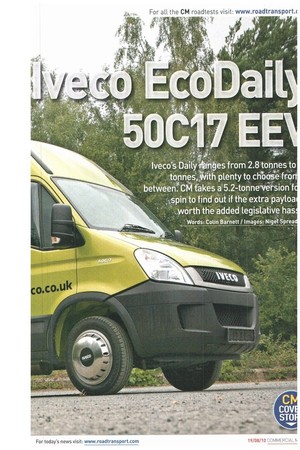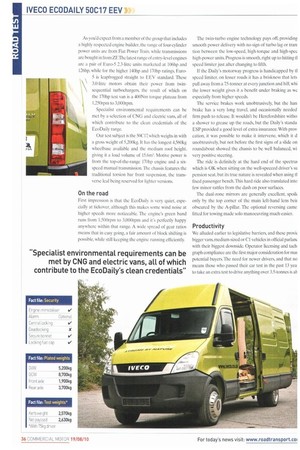EE
Page 33

Page 34

Page 36

Page 37

Page 38

If you've noticed an error in this article please click here to report it so we can fix it.
Iveco's Dai.Cy4gi; §es from 2.8 tonnes to tonnesti)iiith plenty to chlocrse fro between. CM fakes a 5.2-tonne'version f spin to find out if the extra payloa Worth the added legislative has Words: Cohn Barnett / Images: Niget Sprea Commercial. Motor readers are a disparate hunch, but one thing we all have in common is an interest in moving stuff. More so now than ever before, you can add the words as efficiently as possible" to that statement. One way to measure the efficiency of a machine is to consider its ability to shift more than its Own weight. An old lady with a shopping trolley can't do it, but add a bit of power and a bit of technology, and a fit man with a wheelbarrow can.
In road transport. of course, any natural ability to carry loads is limited artificially by legislation. Take the highly popular 3.5-tormer van, which typically weighs 2,000kg, thus failing our acid test, as do most 75-tonners. But with a hit of tweaking, the 3.5-toriner's gross weight can he uprated to anything from 4200kg to 7.000kg.
For the majority of operators. a I.500kg payload is enough, but some can, indeed must, carry more.
Today, more manufacturers than ever are ready to meet this minority demand, but the lveco Daily has always been available well beyond the standard 3.5-tonner: the range extends to 7000kg. but that top rating has only just become available in the current incarnation To add a bit more detail to the range, it starts at 2.800kg and goes right up to 7,000kg. Vans come with permutations from four lengths and three roof heights to give eight body permutations from 73m3 to 17.2m3. The Daily comes with three chassis grades: L Class for lightweight vans from 2,800 to 3,300kg; the S Class of single-rear-wheel 3.5-tonners: and the heavy duty twin-rear-wheel 15to 7.0-tonners. A complementary selection of chassis cabs with single or double row cabs is available with seven wheelbase choices.
As you'd expect from a member of the group that includes a highly respected engine builder, the range of four-cylinder power units are from Fiat Power Train, while transmissions are bought in from ZF.The latest range of entry-level engines are a pair of Euro-5 2.3-litre units marketed at 106hp and 126hp. while for the higher 140hp and 170hp ratings, Euro 5 is leapfrogged straight to EEV standard. 'These 3.0-litre motors obtain their power from twinsequential turbochargers, the result of which on the 170hp test van is a 400Nm torque plateau from 1,250rpin to 3,000rpm.
Specialist environmental requirements can be met hy a selection of CNG and electric vans, all of which contribute to the clean credentials of the EcoDaily range.
Our test subject is the 50C17. which weighs in with a gross weight of 5,200kg. It has the longest 4,560kg wheelbase available and the medium roof height. giving it a load volume of 15.6m. Motive power is from the top-of-the-range 170hp engine and a sixspeed manual transmission.'lle chassis features the traditional torsion bar front suspension, the transverse leaf being reserved for lighter versions.
On the road
First impression is that the EcoDaily is very quiet. especially at tickover. although this makes some wind noise at higher speeds more noticeable. The engine's green band runs from 1,500rpni to 3,000rpm and it's perfectly happy anywhere within that range. A wide spread of gear ratios means that in easy going, a fair amount of block shifting is possible. while still keeping the engine running efficiently. The twin-turbo engine technology pays off, providing smooth power delivery with no sign of turbo lag or tram lion between the low-speed, high-torque and high-spec high-power units. Progress is smooth. right up to hitting tl speed limiter just after changing to fifth.
If the Daily's motorway progress is handicapped by tI speed limiter, on lesser roads it has a briskness that lets pull away from a 7.5-tonner at every junction and hill, whi the lower weight gives it a benefit under braking as we especially from higher speeds.
The service brakes work unobtrusively, but the han brake has a very long travel, and occasionally needed firm push to release. It wouldn't be Herefordshire witho a shower to grease up the roads, but the Daily's standa ESP provided a good level of extra insurance. With prov cation, it was possible to make it intervene, which it d unobtrusively. hut not before the first signs of a slide on roundabout showed the chassis to be well balanced, wi very positive steering.
The ride is definitely at the hard end of the spectrui which is OK when sitting on the well-specced driver's su pension seat. but its true nature is revealed when using 0 Fixed passenger bench.This hard ride also translated into few minor rattles from the dash on poor surfaces.
The dual-zone mirrors are generally excellent. spoilt only by the top corner of the main left-hand lens beir obscured by the A-pillar. The optional reversing came. Fitted for towing made solo manoeuvring much easier.
Productivity
We alluded earlier to legislative harriers, and these provic bigger vans, medium-sized or Cl vehicles in official parlanc with their biggest downside. Operator licensing and taehi graph compliance are the first major consideration for mar potential buyers. The need for newer drivers, and that no means those who passed their car test in the past 13 yea to take an extra test to drive anything over 3.5-tonnes is al!
a consideration, particularly as many vans tend to b by less experienced drivers.
But perhaps the most significant rule is the EU says they must be speed-limited to 56mph (90kr don't have a big issue with moves to control the $. larger vans and 7.5-torincrs as such, although thi affect operational efficiency as motorway journc increase by up to 20%. Our issue is with making ti at the same 56mph as HGVs. The law was ol created by someone in Brussels with no knowl vehicle dynamics.
Vans like this Iveco can generally climb hills a with no problem, even fully laden, while all but t powerful large trucks tend to slow down by various Crest the hill. though, and the heavies' mass lets thi run beyond the limiter, quite legally up to 60mph torway. The van, however, doesn't have enough ma proceeds at 56mph except on steeper slopes. The any reasonably hilly motorway is continuous conflic groups lay alternate claim to the same piece of roac There is an upside to the speed-limiter legislati improved fuel economy as the aerodynamic penalty last 14mph is avoided. So far, we've only tested two
at the new lower speeds. a Ford Transit at 4,600kg and an Volkswagen Crafter at 5,000kg. They returned near identical figures at 23.5mpg and 23.6mpg respective. ly. so the long faces from the men from lveco weren't really justified as the CM calculator spat out an overall figure of 26.5mpg for the Daily, although they reckon it could be improved further.
The real reason for the big Daily's existence, though, is payload, and the big question is what you get for the bother. The good news is that all bar 115kg of the extra 1.700kg of GVW translates to carrying capacity. giving a net payload of 2,630kg.This is within half-a-tonne of some of the 7.5-tonners on the market. Access to the cavernous load space is easy through the tall rear doors and easy step, or through the standard nearside sliding door, which also reaches to full height.
Cab comfort
(loor opening is not as wide as it could be, but inside, there's a spacious feel. The steering column is not adjustable. hut the comprehensively-specced driving seat helps find a suitable position. The lever for the six-speed gearbox is within easy reach on the dash, with many other controls on the column stalks. On the left are one stalk for lights and horn, and a second for cruise control, with wipers on the right. The button on the end of the right stalk is also used to control the trip computer, in conjunction with push buttons on the dash. The trip computer is comprehensive, and includes two memory channels and a fuel consumption display that only seems to operate in 0.3mpg increments.
Chunky heater controls in the centre of the dash contrast with the relatively dainty minor switches below. Below these is the ashtray, which has lighter socket and a 12V auxiliary power socket. The audio unit is pretty comprehensive, featuring radio, CD. MP3 and USB input functions. together with Bluetooth telephony, all controlled hy buttons on the fourspoke steering wheel.
Storage is generous, with two door pockets each side, a pop-out cupholder each end of the dash, an elastic net on the rear wall and a drop-down bin under the passenger seat. In front of the passenger is a double-deck glovebox, albeit too small for A4 paperwork. and an open bin in lieu of a passenger airbag. There are a pair of roof shelves inside the cabin, while a lack of space for large items like an overnight bag is compensated by plenty of space above the cab, accessed from the load area.
The only trick the Daily really misses in comparison to its modern rivals is a drop-down back for the passenger seat. •




























































































































